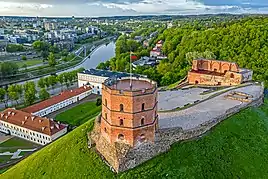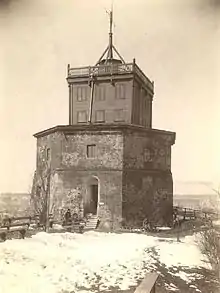Gediminas' Tower
Gediminas' Tower (Lithuanian: Gedimino pilies bokštas) is the remaining part of the Upper Castle on top of the Gediminas Hill in Vilnius, Lithuania.
| Gediminas Castle Tower | |
|---|---|
 Tower in 2021 | |
| Location | Vilnius, Lithuania |
| Coordinates | 54.6867°N 25.2907°E |
| Built |
|
| Architectural style(s) | Brick gothic |
History
The first wooden fortifications were built by Gediminas, Grand Duke of Lithuania (c. 1275–1341). The first brick castle was completed in 1409 by Grand Duke Vytautas. The three-floor tower was rebuilt in 1933 by Polish architect Jan Borowski. Some remnants of the old castle have been restored, guided by archaeological research.
The hilltop can be reached on foot or by lift. The tower houses a museum exhibiting archaeological findings from the hill and the surrounding areas. This building is three stories tall and is made of decades-old bricks. The museum has models of Vilnius castles from the 14th to the 17th centuries, armament, and iconographic material of the Old Vilnius.
Gediminas' Tower is an important state and historic symbol of the city of Vilnius and of Lithuania itself. It was depicted on the former national currency, the litas, and is mentioned in numerous Lithuanian patriotic poems and folk songs. The flag of Lithuania was re-hoisted atop the tower on 7 October 1988, during the independence restoration movement.[1]
A reconstruction of the Royal Palace of Lithuania was completed in 2009, and is located near the base of the hill upon which the tower stands.
Legend
.jpg.webp)

Long ago, the Lithuanian Grand Duke Gediminas was hunting in the woods of Šventaragis Valley. The hunt was successful, and Duke Gediminas brought down a wild bull on a hilltop; but he grew weary in his limbs, and so the duke retired and spent the night there. Now Gediminas had a dream that, up on top of the same hill where he had been hunting that day, stood a great wolf made of iron, and it was howling as loudly as if it were a hundred wolves.
The Duke asked the court magician Lizdeika to explain his dream to him. He interpreted it thus: this was an omen indicating that he should build a city in this place, which would later become known around the world and would become the magnificent capital city of Lithuania.
Gediminas, obeying the will of the gods, began to build the future capital city, and a castle in the centre of it. The city was named Vilnius after the nearby river Vilnia. Gediminas' Tower is the only surviving part of that castle built by Gediminas.[2]
See also
References
- "History of the Lithuanian Flag". Seimas of the Republic of Lithuania. Retrieved 5 December 2008.
- "Gediminas Castle | Built by the Duke of Lithuania Gediminas". Archived from the original on 15 January 2015. Retrieved 15 January 2015.